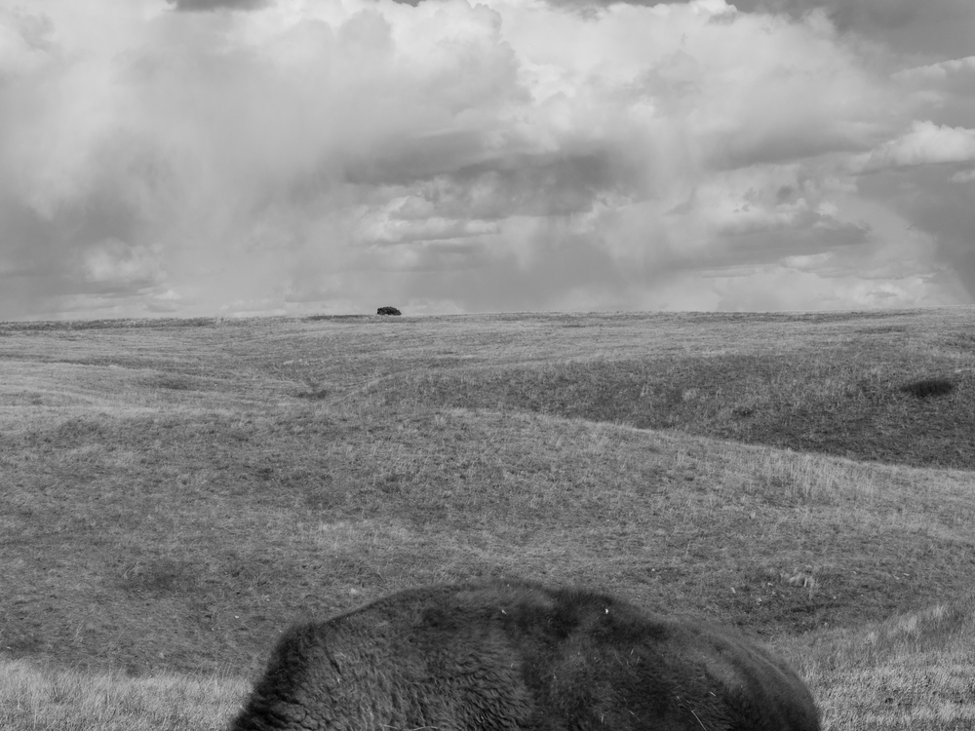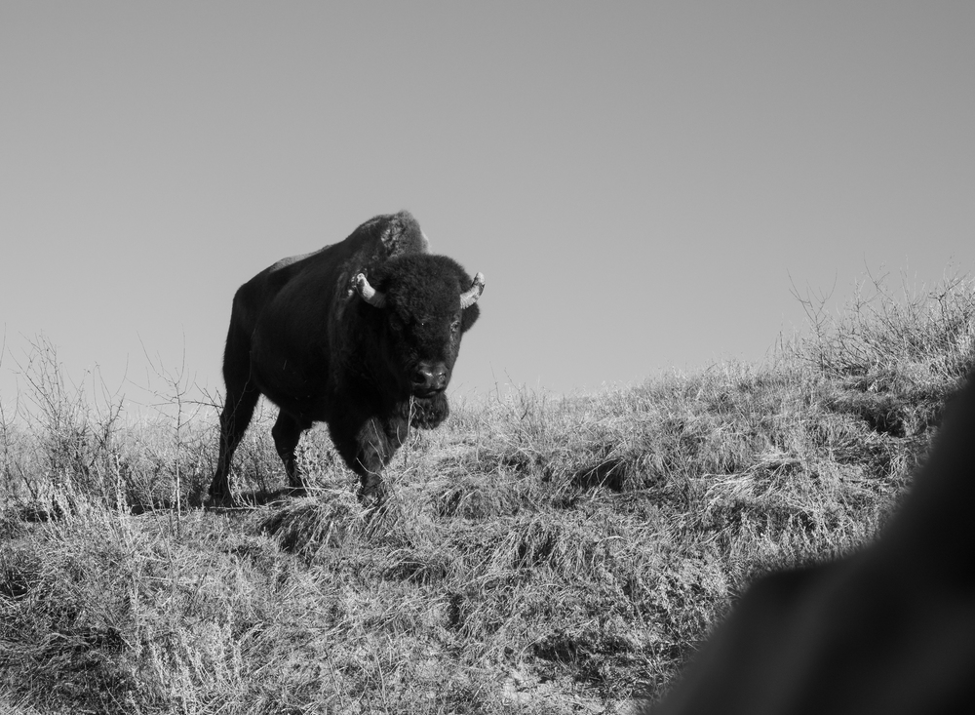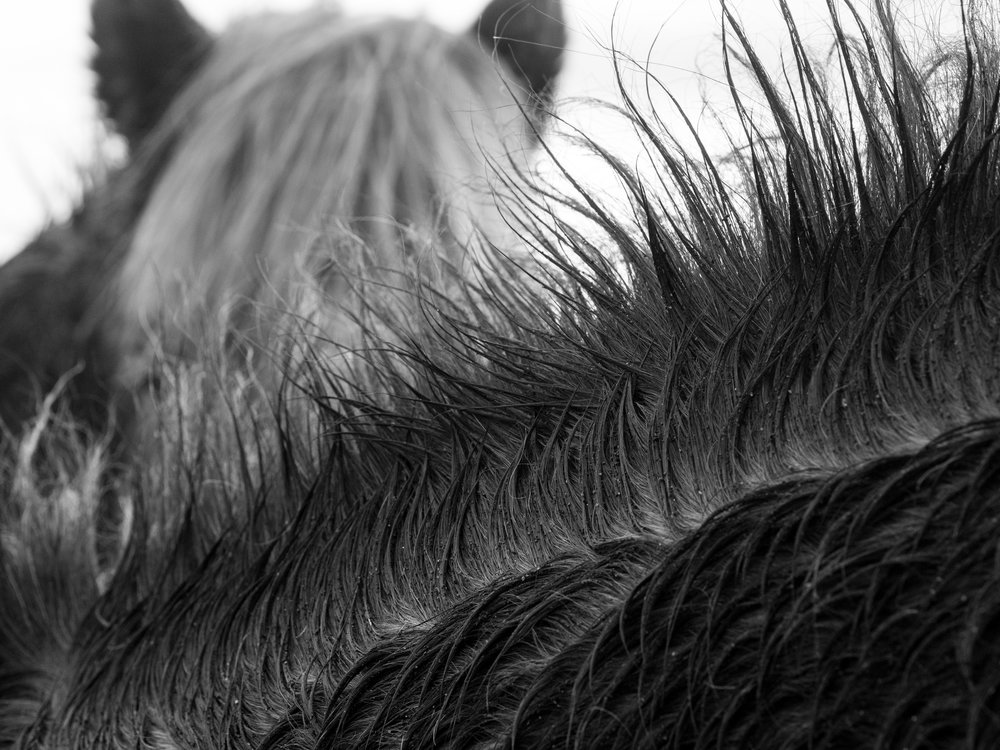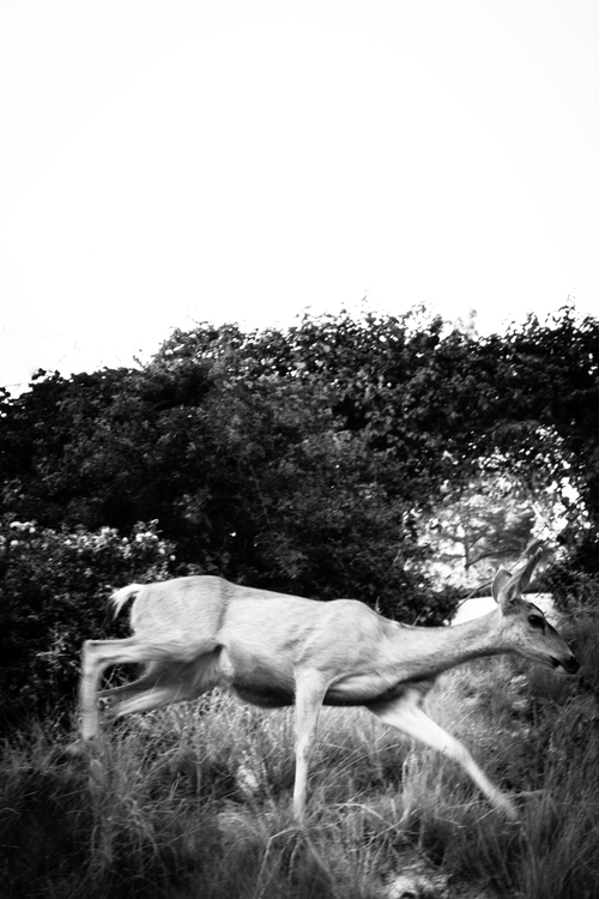by Amanda Kallis

The last snow on the planet will be red: red from bacteria in spastic bloom. A feast on arctic plains before the lights go out. I hunt for details like this, the lurid and symbolic, that will give the end of the world some teeth in my mind—because, try as I might, I can’t make it seem real. This remains true for me in spite of recent events; if anything, my focus has shallowed.
The end makes me want to act out of character—you see I am generally good, except perhaps when taking photographs. To be a great photographer you must be rude, I think. Even more so than in writing, which has the benefit of obscuring devices (words, fictions). I’ve quoted people directly, put it into the mouths of characters, and they don’t notice the words were once theirs. Yet I can’t say a portrait is of someone else. I don’t wish to be mean, or, more accurately, I don’t want to be perceived as mean, and I am too shy to deal with the aftermath. The few times I’ve been caught with my camera lofted, the shutter click obscenely loud, and someone has objected to my photo taking, I’ve wanted nothing so much as to dig myself into the earth. And so, lately I am settling for being a good photographer . . . Of course, I hate having my own picture taken. They won’t do it they way I would, and also, I want to look good, as we all do. Another example of how you must be unfair: above all you must never be objective, or the resulting image will be flat, lifeless.
In the beginning, some photographers contorted themselves so their art might be mistaken for paintings, processing the image until it blurred soft. Clarity lacked emotion, the thinking went. Clarity was inhuman. It betrayed the presence of a machine. The pictorialists, as they are called, had a reputation to salvage—this even before photography was automated in the point-and-shoot digital age I grew up with. With photography, the artist, already self-despairing, must contend with a machine as a middleman at the core of their creative process. A box with bellows or a plastic disposable or an app on a phone—whatever it is, it’s in-between. Someone else made the machine I use, and someone else prints the photographs I take, and usually something or someone else is the content of this photograph that I call mine. Pictorialists also had a language to create with their new medium. What makes a photo good and not sluttish? (All photographs are a bit sluttish. Democratic, please. Inexpensive, accessible. Domestic, yet institutional.) We keep track of people with photographs, we track ourselves with photographs. Photography is easy, that’s the problem. Too many people can do it. You can take anything for yourself, in a photo. It can be so many things. All you have to do is be there, index over the trigger, ready, sensitive as silver to light. All you have to do is fall for the thing in front of you and possess it.
I thought to myself: I can photograph animals, landscapes, spare objects. These subjects won’t have an opinion, and so the imposition of my opinion won’t bother them. I’ll be in the clear.
(The sign said No Photographs, but the image was too seductive, and so I took it, angering my boyfriend—and only felt bad about it later, when the photo turned out to be a poor one. I got in a fight for this, I thought to myself.)
I greet strangers:
Have you seen the frogs wash up on the shore? Before they fell from the trees and into the tide, they were so loud you couldn’t sleep, they were good luck. A cacophony of frogs, splayed on the shore. What should we do about the frogs? (I don’t greet strangers. This is a lie. I take my picture and run.)
I began taking photographs as a teenager. I’d already liked looking out of windows, looking while walking or driving. I suppose I was quiet; I was told I was nice. The camera interacted with things as I looked into it and out. I also took many photos of myself, preferring the low quality of my computer fisheye, the MacBook Photo Booth presets. I wanted to look at myself looking different.
I’ve heard teenagers are the way they are because they are grieving childhood and don’t know it. Instead teens act out, slam doors, and are often overwhelmed. I don’t remember acting out, but I remember a sudden anger that would appear from outside of myself and infuse my body for a time.
If so, our first mourning is without our knowledge. Before we know it.
But I would have said that grief is terrible knowledge.
I don’t say that now.
Recently a child, I stood there toeing the tile’s edge watching my stepmother pin hot rollers to her scalp. An elongated wet in the crotch of my pajamas, reaching around to the back. I don’t have a tampon, she said, furious. Don’t you know my days of periods are over? Years later she would grip my wrist and force my hand to her growing abdomen. It’s so hard, she said, feel it.
They would stuff the bison to save it. Here is one beginning of an American conservation movement, and I’m taken by the idea. Press it in time. Slip glass eyeballs into the sockets, framed by those pretty eyelashes bison have. It is the photographer’s impulse: freeze, collect. String up with wire. A writer’s impulse as well: record, recollect. To forget yourself looking. Look while it lasts. Look to make it last. The species are thinning out; so much hair on the ground; forty pounds and more on the floor. How many times over? When it comes to the end, I cannot keep the image in my mind, only details: hair lost, pounds lost.

There were once so many bison that spring came early.
(They spread seeds in their travels, aerated the soil, softened the climate.)
There were once so many bison that spring came early.
It used to rain more. But I was a child and there were fires then too. I saw ash fall from the sky long before I ever saw snow fall. I spun around and tried to catch it on my tongue, because that’s what children do in movies. I remember a canvas of smoke and helicopters dumping fantastic curtains of sand, but even more than that, I remember the quiet of rain, a sound that outlined the room. And then the landslides followed the storms, blocking the roads, and the mountains so suddenly green. How could there already be less rain? Even as a child I wanted to remake a scene I’d seen before, spinning with my tongue out, yet I caught ash and not snow on my tongue. It was fun. Later I tried to do it with writing. You see, I’ve long loved documentary photographer Justine Kurland’s images of teenagers. The teenagers always seem about to set fire to a shed, or as if they’ve recently run away, or lost their virginity. I enjoyed writing stories behind the images, making up worlds for them to destroy. Here were the types of teenagers who broke rules. It was only recently I learned that she poses her subjects—a fact she isn’t at all duplicitous about, I’d just somehow missed it. I’d missed it despite the grace of the lighting, the incredible expressions of the models’ faces, the delicate slump of their bodies, the perfect unevenness in how they gather around each other. I swallowed my disappointment. But what was I so disappointed about? It struck me as a form of cheating. Then I realized I could have been posing subjects this whole time, had I been bold.
She took my hand and forced it to her belly.
I asked them what it was, my stepmother said. She said she looked pregnant and she did. Rounded beneath my hand. My hand aware of the shield of her belly, her belly close packed by what was inside. However much I wanted to, I couldn’t move my hand away; that would be cruel. She needed to tell me what it was in her belly, but I already knew. Remission was over, had been over, and we were back at the beginning of the end. I’d known for months—hadn’t she? We’d been through this once before. Maybe she couldn’t know. It was too visible, too real. To have to carry that on you through the day, roll on your side with it while trying to sleep at night, and wake, fetal position, curled around it, a stone cradled against your spine.
It’s what’s killing me, she said sobbing, and I’m not ready to die.
I confess I don’t care that horses aren’t native here—that feral, they’d graze until the rangeland is barren. I am a bad environmentalist. I don’t have the big picture. I’d let them eat and pound the earth until the plains are a bald pate, compacted shiny and hard. I’d let them until the rivers change course, let them ground the mountains beneath their unshod hooves, rounded to their greedy wishes. More horses than land, the land moving with a sea of backs, hills of them, plains of them, a living belt of hide and muscle. Break legs running. The world is ending; let them run.

There were once so many passenger pigeons, flocks would cover the sky for hours.
There were once so many passenger pigeons, flocks would cover the sky for hours.
Again and again people asked me: Were you close? Which seems an odd thing to ask after someone dies. Can a common response be odd? —It can. I thought about how much she hated her feet, the length of her toes. Before their wedding she took us to get our nails done, but no one told us there would be a wedding that day. This was a betrayal in that it wasn’t acknowledged as one. She groomed with intense care. I thought she was impossibly feminine; this would have surprised her. Sometimes I wished to be as tall as she was, if I’d be a different person that way, stronger—a silly idea, but what if. If I was mean to anyone, it was her. Children are all the more mean for the fact they don’t understand what they do. In Texas, my stepmother took us riding. Horses have such weak ankles. On the news the fires wash the entire frame red. She liked to talk about how petite I was, the breadth of my vocabulary, the time I spent in books—both sweetly and as if it were a thing I’d done to get back at her. She commented encouragements on every one of my photos the instant after I posted them. I would delete Facebook, but then I might lose these comments, much as they are all the same. Of her childhood she only said it was not easy. I’m not sure if I asked or if it was a thing I assumed. (He said: You didn’t really know her though, did you?)
I commit details to memory, unconvinced. The last snow on the planet. The insects, the frogs, the bison, the birds. The length of toes. All hair lost on the ground, drifts of hair caught between fingers.
Perhaps it is our job after this to go out and photograph the rocks and the trees. Spiders and house cats. They won’t object. Pose in front of them, pose our families. Caption and comment. After all this, when we can go outside without fear again, the danger is we will forget the world might be ending. The sun is out. Take a picture. Our pictures will all look the same, but that is fine, like those of the Eiffel Tower, or the Grand Canyon. A scroll of places. Identical pictures, unless you’re in the frame. We were here, we were here. Unlike many others, I don’t see a problem with these rote photos, even the trendy kitsch ones; I don’t think it lessens our experience, as if the populace were so present for each other and our surroundings before. There is a ritual to dumb photo taking, and rituals are avenues to experience if you let them be. Yet, to be honest, I’ve never been very good at living in the moment, so perhaps I notice the effect less.
If you are human: take a photo of yourself a thousand times over. A thousand angles, lightings, effects. Don’t worry. Selfies are narcissistic only if you trust the camera. But cameras make hybrids of us. Don’t forget. There is so little a photograph can prove.
Perhaps we could try to pose so as to seem natural. A more accurate photo than a “candid.” Perhaps we should do this in our homes, not just with with the rocks and the trees. We could emphasize certain aspects, stylize, suggest the importance of what is omitted as well as what is shown. Here I am beside you. And if we all did it, the sheer scale would sanctify the ritual for us, weigh our actions with import. The machine and the motion it makes. So many hands, so many faces, so easy. A continuum of pictures, a phrase repeated. It is very difficult to take a photo of Joshua tree that shows why it is so lovely. It’s an issue of scale. No adequate comparison. The desert is so wide, and the boulders piled so large, the mountains in the middle distance like piles of boulders, the trees poking out of them like sticks. You could find a technically better photo of Joshua trees on the internet and use that. An ideal photo. Yet it would be worse, it wouldn’t be the same. (Oh, but you found it, perhaps that’s enough to make it yours.) The only time I’ve come close to taking a good picture of a Joshua tree was by picking out the fronds, shooting so close that it became abstract. But I imagine you could do it by taking so many pictures of Joshua trees that you ran out of film, ran out of space on the memory card, until you overwhelmed yourself with looking.
I went out shooting, driving with my camera on my lap, and found a man dying in the street not far from my apartment. I’d heard it but hadn’t seen it happen. A huge sound. The firefighters were unloading, but the ambulance had yet to arrive, and he was uncovered, unattended. There was nowhere to drive but beside the man, and so I was rolling forward slowly, wondering, do I take this picture? His motorcycle was initially difficult to identify as a motorcycle. One hand rested on the wheel and the other on the shutter. If he had been wearing a helmet, he wasn’t now. Dying or dead, his hand stretched out to me, five feet from my window, which was lowered. I thought, if I were a real photographer, I’d take this picture, and I could see it then in my mind, beautiful and tragic and mundane—how often cyclists die in the street—the settings ready on my camera.
I drove on.
Thank God, I thought later. What if the photograph had turned out bad?
We have so few methods to count time, to mark it as it passes. The calendar and the clock the least of them, I think we can all agree now. Frame it with weddings, birthdays, graduations, funerals. (Suspended, however.) Music, then. Celluloid, albums that creak as you open them, pixels, Zinco letters. The news the news the news, does that count? (I’m not sure it does.) A horse stranded on the shore, isolated by the lens. Lines of cars. Spaced people. People emptied. Birds and bison, insects and frogs. (You named them, but you forgot to number them.) The lakes sink down, their walls calcium white. Fires on the tv wash the entire frame red. Fragments of faces. Left to right. Scroll. Were you close? Teenagers strike a pose. The horizon is always receding. I barely remember what the dying man looked like. Why do I want to? Skim to the end. When will it be over? Give me the last page, I can handle it. A flash, let it be a bang. Anything but a sieve.
When my stepmother died, I was living across the country. No one told me I had to come home, as there was no funeral. Everyone was bone-tired. She’d been sick a long time. Months later there was a memorial, which I learned was different. Do you wear black to a celebration of life, I wondered. I bubbled with the wrong feelings. I wished for a rabbi, or a hippie spiritual, something. In the vacuum, my extended family members came up to me, excited to meet my boyfriend, and wishing that I would reassure them somehow. How horrible, that someone their age should die. She was sick a long time. Introduce me to your boyfriend, he’s handsome. I agreed, and showed him off, talking him up. Although I’m not religious, suddenly I wanted to hang shrouds over the mirrors, if only for the beauty of it, and so people would know whether they should whisper or speak at a normal volume. One or the other would be fine, but both was horrible. Separately, people felt sorry for themselves, and failed to forget themselves, as did I; I felt alone.
When I did cry, at the picture slideshow, I debated if it was the proper amount. (Were you close?) There was no room for me. No space to speak. This ritual forgot to hand me a role, and without one, I felt false. No, I acted false.
There was also a series of photographs framed and mounted on an easel. My boyfriend stared at them and asked who it was, and it’s true, my stepmother was unrecognizable. He had only seen her dying and in the pictures she was well. Her hair thick, blond, and swimming around her head. Morbidly I wondered what my last photograph would be, and if anyone would want to see it. The last photograph I take, the last photograph taken of me.
The first popular models of photography were corpses, as the exposure took many hours. Later came the tradition of immortalizing the dead with mourning portraits. Now it has passed from ceremony into taboo. What a loss, I think. But I hate to be photographed. I would even—especially—hate it when dead.
We should attempt finding ceremony in the end of the world, much as we try to avert it. Traditions are for times when no one knows what to do and help to avoid unnecessary awkwardness. I would like dances that take days to perform, the carving of idols, a uniform. Gatherings in the streets and parks. Recitation of the companies and institutions that flout the facts, that refuse to change. Something like a protest, in that I would like it to disrupt daily life. Daily life is disrupted now, but all I feel is numb. Unfocused. A vague guilt. That’s why I think it needs a shape. Modern traditions for the apocalypse. I’m no tree hugger but I can give it a go. We can string necklaces of blanched coral around our necks. Collect trash. Press flowers into pages. Build shelters. It can be simple, although I’d prefer it to be elaborate. I want lines to memorize, to learn movements until they are thoughtless. I don’t mind if we do it to be ironic, or if it’s bullshit, or rote. But it’s better than what we have now because what we have now is lonely. What we have now offers no inroads to feeling. The mistake is in approaching the end of us rationally and individually; it’s simply too big. It crowds us out. The scale is unimaginable. We haven’t claimed roles for ourselves—no surprise there is such mass denial. Even though I believe it, I don’t feel it. When I do feel it, I feel helpless. (Q: What is grief? A: It’s what is too large to feel. Q: Why can’t we accept the end of the world? A: Because we are still grieving, and we are very bad at it.) We should make eulogies in the captions of our pictures.
If I really thought the world was ending, I wouldn’t have children. Would I write? Embarrassing: A not-so-small part of me supposes I might become famous. This is incompatible with the near end of the world. It’s not that I hope we will fix the planet (though of course I do). It’s that I’m sure, sure as a zealot, that we will. I have not, it seems, resigned myself to being a good writer, and so this rudeness persists. At the same time, I think my writing would be at its most gorgeous if I were among the last writers, attending the end of something much bigger than myself. What an incredible subject it would be, if I could find a relation to it. The quiet of insects, of birds. Flights of silence. Every writer wants to have the last word. But if I am honest, I think the end of the world is meant for photography. Pictures are about moments. Who will take the last photograph and what will it be? A photograph of themself, of a still life, of the changed landscape, of a loved one? And who will write the last word? No matter. Everything is beautiful at the end of the world. They will be great by sublime context, by timing, dumb chance. Imagine how spectacular the red snow. Oh, but if you could call it one, the last photograph taken is likely to be the frame of a video, no one behind it, no one to view it, rolling until the power runs out.

Perhaps if I were a great photographer, I would have taken the picture of my hand forced to her belly. I can be an amateur photographer; I don’t mind anymore. My ambitions have reshuffled. But I wish I would have asked her, and I wish she would have said yes, and I wish I had this photograph to look at, now that she is gone. I wish I had said, I will write about you one day, what should I know?
Amanda Kallis is a writer from Los Angeles living in Providence, RI. She holds an MFA in Fiction from the Iowa Writers’ Workshop. Her work has appeared in Catapult, Black Warrior Review, McSweeney’s Internet Tendency, The Cincinnati Review, and elsewhere. Currently she’s working on a speculative novel.
